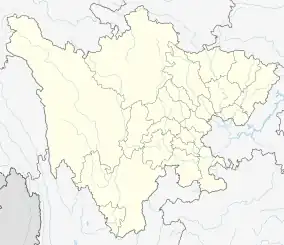Baiya
柏垭镇 | |
|---|---|
 Baiya | |
| Coordinates: 31°27′21″N 105°55′41″E / 31.4558°N 105.9280°E | |
| Country | China |
| Province | Sichuan |
| Prefecture-level city | Nanchong |
| County-level city | Langzhong |
| Population (2020) | |
| • Total | 22,158 |
Baiya (simplified Chinese: 柏垭镇; traditional Chinese: 柏埡鎮; pinyin: Bǎiyā Zhèn) is a town in the county-level city of Langzhong, Nanchong, Sichuan, China.[1] As of 2020, Baiya has a population of 22,158 people.[2]
History
On August 2, 2005, the now-defunct townships of Gaoguan (Chinese: 高观乡), Jinyu (Chinese: 金鱼乡), and Yunong (Chinese: 裕农乡) were merged into Baiya.[3]
Administrative divisions
Baiya administers four residential communities and eight administrative villages.[4]
Residential communities
Baiya contains the following four residential communities:[4]
Administrative villages
Baiya contains the following eight administrative villages:[4]
Demographics
According to the 2020 Chinese Census, Baiya has a population of 22,158 people.[2] 3.56% of Langzhong's total population lives in Baiya.[2] The town's males comprised 51.18% percent of the population, while females comprised 48.82% of the population.[2] 13.09% of the town's population is 14 years of age or younger, 49.76% is between the ages of 15 and 59, and 37.15% is 60 years of age or older.[2] 29.72% of Baiya's population is 65 years of age or older.[2]
Historical populations
As of the 2010 Chinese Census, Baiya had a population of 31,235, up from the 19,920 recorded in the 2000 Chinese Census.[5] This increase is likely due to the expansion of the town of Baiya, which incorporated a number of now-defunct townships in 2005.[3]
See also
References
- ↑ 2020年统计用区划代码(阆中市) [2020 Statistical Division Codes (Langzhong)] (in Chinese). National Bureau of Statistics of China. 2020. Archived from the original on 2021-09-01. Retrieved 2021-08-31.
- 1 2 3 4 5 6 阆中市第七次全国人口普查公报 [Langzhong Seventh National Population Census Report] (in Chinese). The Municipal People's Government of Langzhong. 2021-08-30. Archived from the original on 2021-09-01. Retrieved 2021-08-31.
- 1 2 阆中市历史沿革(第二页) [Langzhong Organizational History (Page Two)]. xzqh.org (in Chinese). 2015-04-16. Archived from the original on 2021-09-01. Retrieved 2021-08-31.
- 1 2 3 2020年统计用区划代码和城乡划分代码(柏垭镇) [2020 Statistical Division Codes and Urban-Rural Division Codes (Baiya)] (in Chinese). National Bureau of Statistics of China. 2020. Archived from the original on 2021-09-01. Retrieved 2021-08-31.
- ↑ 阆中市历史沿革 [Langzhong Organizational History]. xzqh.org (in Chinese). 2015-04-16. Archived from the original on 2021-09-01. Retrieved 2021-08-31.